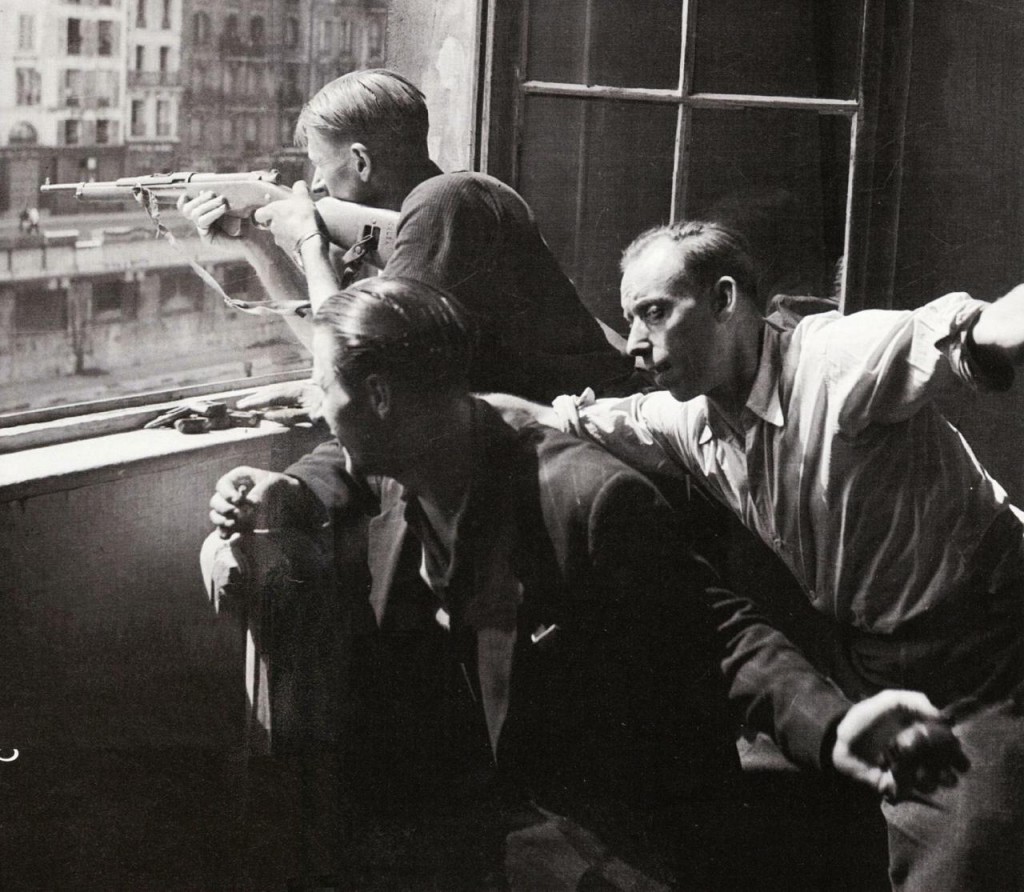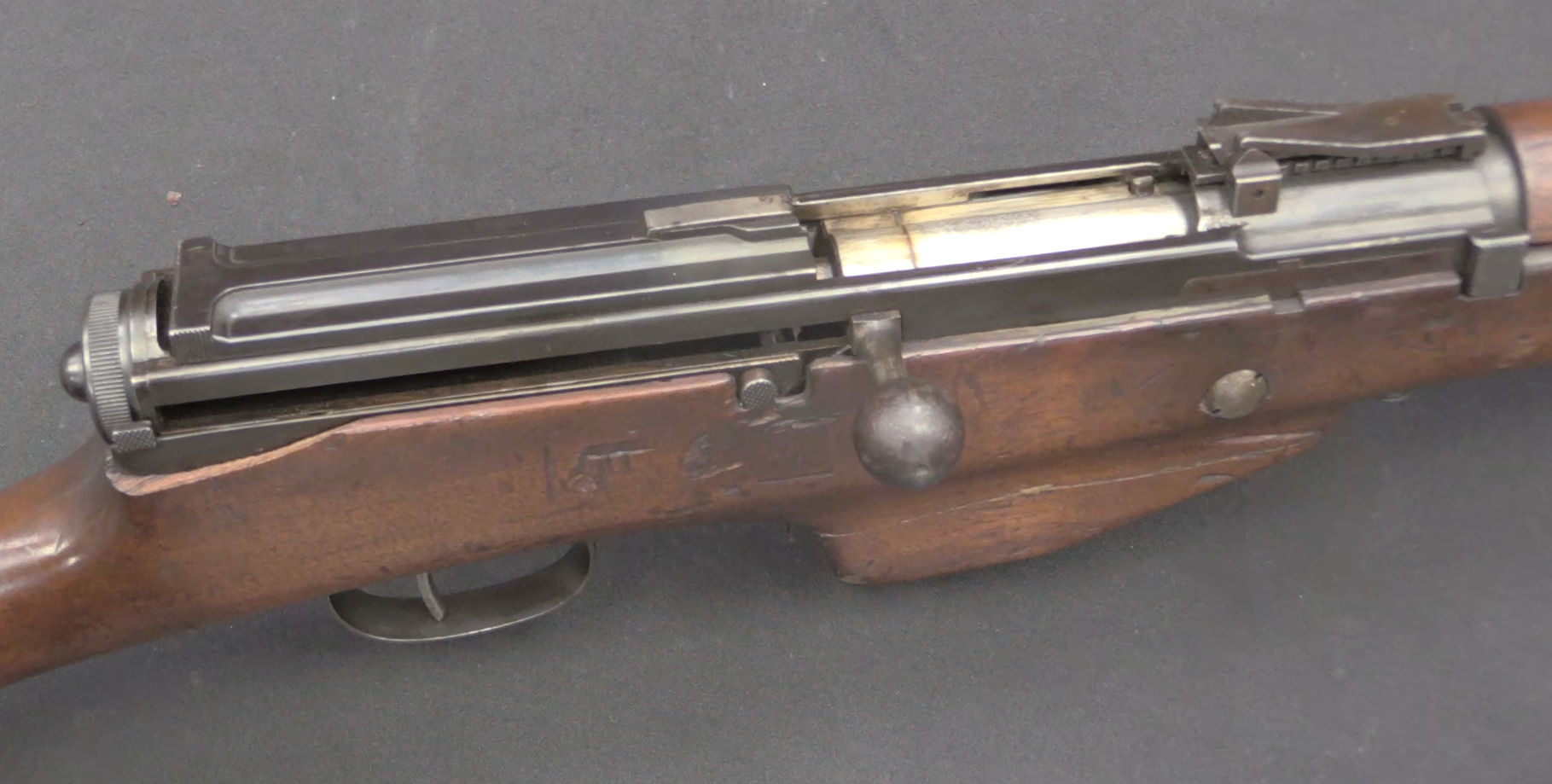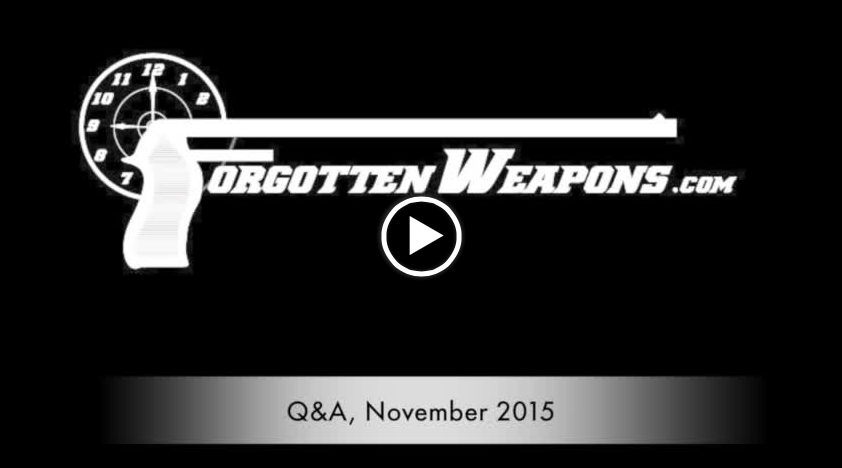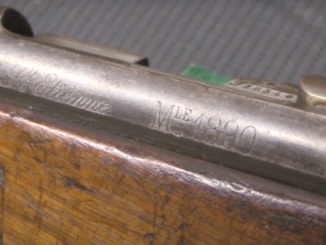
Members of the French resistance in Paris, August 1944. Interesting to see that the shooter has an M-16 Berthier with a 5-round magazines, but the window sill has a pile of three-round clips. Also interesting that the two guys are both left-handed – when I found the photo it had been reversed, making them appear right handed. The bolt and sling attachments on the Berthier give it away, though.




Don’t think the photo is reversed. Sling hardware is always offside from the bolt handle in the closed position so the bolt handle doesn’t dig into your back when the rifle is slug European style. The shooter really is left handed, if not especially clever.
You could see in photo are French Policemans from Paris Police headquarter (Prefecture of Police of Paris) shot Nazi soldiers (looters & illegal immigrants) in back in street and/or other side of River….
For Left hand, is more left eyes (for the shooter) … French Armed Forces shool you to take longweapon in function of your eyes more than your hands.
SNMP I believe your correct .. note the small, “egg” shaped item in the hand in foreground .. ah ha a grenade I believe about to be chucke! Second fellow also!
Is this perhaps a still from the famous footage of the truck full of Germans being bombarded from above? The truck catches fire, and a German, engulfed in flames, fall over the tailgate.
Probably a staged photo… but a lot of photos from then (and present) show folks hanging out of a window when they shoot.
If you fire at someone in combat like that you would not last long enough to pose for pictures.Both 3 and 5 shot Berthiers were common in the resistance the clips were always a problem ( the 3 round versions work much better than the 5 round versions). I think this is a staged or propaganda photo; probably after the liberation as it would not have been smart to point a rifle out of the window under the German occupation.
Well Andrew, your final point is true, but this surely may have happened in the final 24 hours of the German occupation.
On a more whimsical note, I have an explanation for all of these left handed blokes in one photo: they are family Kerr! You see, the old French monarchy employed large numbers of rebellious Irish and Scot mercenaries and some survivors settled in France. Now the Scots Kerr clan are so notoriously left-handed that their medieval castles had a counterclockwise screw to the steps in their castle keep. (Can be seen today, mostly in a ruinous state.) So I reckon the men in the photo are Frankisised remote cousins of me!
Thomas Kerr
Hmm, I can’t check it right away, but perhaps someone who has an M16 Berthier (5-shot) would try and tell whether the 3-rd clip would work in it. If so, that would make perfect sense (allowing the 5-shooter owners to use both style clips) – but on the other hand, a military and reason are getting so often on collision course…
His style of shooting is certainly suicidal, but hey – nobody is born a soldier. Maybe nobody just taught him that, or just where he was shooting nobody shot back. In real combat he wouldn’t last till the shutter’s snap, that’s for sure. Anyway, he’d be OK, if his friends wouldn’t blow him to smithereens with these grenades. These are (or at least the one nearer the camera) the Ei-Hgr39s, with friction fuzes, and the screw cap seems to be torn off in the grenadier’s other hand. That would leave them ca. 5 sec. before ka-boom, and the guys seem to be consumed by idle chatter, instead of making a serious effort to get rid of the damn thing. ‘Say, Edouard, shall we drop it to the left or right?’ ‘Damn if I know, Raoul, let’s put them aside and toss a coin first’. This makes it even more a posed photo – from experience these fuzes, when activated, give off quite some smoke. Or at least East German variations used on the lacrymatory grenades by the Polish riot police in the 1980s did – and I don’t mean the main charge, which ignited afterwards, but the black powder delay train set ablaze by the friction wire being pulled off. Do you see any smoke here, or am I not that blind?
Neat photo. For black and white French stuff, have you ever seen Gillo Pontecorou’s (and I am so not certain about that spelling) late 60s “Battle of Algiers”? Probably the best urban combat move ever made (plus it is to the MAS 38 what “The Dirty Dozen” was to the M3.) Hesitate to mention it here because I was introduced to the film by Tejano revolutionary friends to the left of Trotsky, but it is one hell of a flick.
For neat stuff involving the 8mm Lebel caliber, look to the 8th Illinois National Guard, who were federalized at some point as the 370th Infantry. Most of the African-Americans who served in WW1 were stevedores and general non-combatants, but the 8th were hard core front line. They did their pre-deployment training here in Houston at Camp Logan (where the Memorial Park soccer field is now) right after the 24th Infantry’s 1917 Camp Logan Uprising. (Proud black veterans of the Apache War, San Juan Hill, and the Moro Uprising versus the all white asshat 1917 Houston Police Department, deployed in units through what are now called the Old West End and Rice Military neighborhoods, fix bayonets and march over Shepherd’s Dam and down San Felipe (now West Dallas), the biggest mutiny in the history of the US armed forces. The 24th had put up with unbelievable crap, and if you look at the story their motto as they marched on downtown Houston – “Kill all the white folks you can, and save a bullet for yourself” – is justifiable. A dozen or so troops were executed for their role, and the whole thing was denied under “national security” well into the 1980s.
And then the 8th Illinois showed up at Camp Logan for pre-France training (along with the all-white 9th Illinois National Guard, who said “If the black troops from Chicago can’t ride the streetcars, the white troops from Chicago won’t ride the streetcars either) and were basically restricted to Camp Logan. (Aside from some local recruiting – the great-uncle of an 84 year old neighbor was signed up out of Beaumont, and did basic in Houston and fought in France with a Chicago outfit, which is how I found out about all this.)
And when the 8th – soon to become the 370th Infantry – were deployed to France in 1917 no American generals wanted to have black troops from the South Side with officers from Bronzetown under their command, so they were given to a French general. And black troops from Chicago who had trained in Texas fought under French command through Chateau-Theirey and Belleau-Wood in French greatcoats and helmets with 8-mm Lebel rifles. And French rations, although because they were all Baptists the French gave them a double sugar ration instead of the wine ration.
I turned my initial research on the 8th Illinois in France (summarized above)over to the National Buffalo Soldiers Museum here in Houston, and they may have come up with more information since. The 24th and the Camp Logan Uprising… well, it’s not really classified any more, but all the records got lost. But it was the largest infantry exercise in Houston since San Jacinto, and 1903 Springfields saw heavy use.
Jim, that’s a tremendous piece on history and humanity that you’ve written — thank you. It brings to light an often “inconvenient truth”, but also shows that even in those distinctly segregated times, there were many who were fair-minded and not racist in their collective outlook.
Incidentally, speaking of the Battle Of Algiers, a few acquaintances of mine from a long time ago lived through the War In Algeria. A couple were native Algerians whose families had no choice but to stay and endure, and another grew up as the son of an American diplomat based in Algiers. He and his family were lucky to get out alive when the French paratroopers rescued them.
Hi Earl,
its and irony that what French resistance had in store for German occupiers they were themselves treated with just couple of years later during War of Algiers, as you mention. “Wheels of fortune in battle change by minute” (I believe it was quote from Bonaparte).
Good contribution Jim!
As we learn bit more, we find it was people more than guns who decided course of events. I particular, relating to subject you picked – the soldiers of black origin in lines of U.S. military and how precariously their command was managed. I have my own story to tell. They were, according to observation of my father (who ventured to Germany in first week after capitulation in search his father) outstanding drivers and were putting on real show with their Jeeps. Also, some of them showed up in units liberating western part of CR and they were generally well received a liked by locals. Always helpful and friendly with their broad smile adorned by shining white teeth.
I believe that one of my great uncles was in the 8th. He said that his unit had been assigned to the French Army.
My grandmother trained as an ambulance driver, but I don’t believe she ever made it overseas.
My great uncle brought back a P-08 Parabellum, which he gave to my grandmother for protection. She eventually traded it back to him for a Colt Detective Special. Boy would I love to get hold of that Luger!
Hola, more on that dear Jim in Houston! completely new to me, but that’s perhaps because I am Dutch. They must have been seriously kick ass troops to endure all that and still be willing to fight for their country. I would have refused!
Black troops generally had a good reputation, despite the tendency of the Army to assign them White officers, whose major qualification seems to just to have been Southerners, who allegedly knew how to “handle” (subjugate and degrade) Blacks.
There were a considerable number of Black units in Italy during WWII. Insofar as I can tell, they were generally treated the way the Japanese treated the Koreans whom they employed. General Mark Clark was no hero in any of this.
It was not unusual for White officers in segregated units to be of lower quality, and indeed to not be qualified for the branches concerned. Black units in Korea had a very bad reputation, mostly because by that time the Army had been ordered desegregated and there wasn’t even the pretense of anyone caring what happened in or to those units.
The Army had supposedly desegregated after WWII, there was only 1 ‘Negro’ regiment left, and it was a dumping ground for incompetent officers, badly trained, last in line for gear and supplies. They were involved in the early catastrophes the US Army experienced in Korea.
Granted this is genuine shot, it proves one and the same over again: people tend to be ‘heroes’ in high hour of conflict when everything was pretty well determined by someone far more mighty. So, we have these outbursts of nationalism, which are often nothing more that nasty fits of vengeance. By saying this I do not intend to downgrade work of resistance, which was most valuable on fields of intelligence given to allies and help to shot-down aircrews.
Speaking on subject – French designed and made weapons; I must say that until recent I did not know much about history of their rifle and machine design development which I attained keenly courtesy of FW. I have lot more appreciation of it now.
Well I spent an hour or two writing a history about how the 1st Kansas Colored Militia, despite being 2-1 outnumbered, kicked serious secessionist cavalry butt at the battle of Island Mound 8 miles southwest of Butler Missouri (where I grew up) in late October 1862 and after proving that black troops with Prussian muskets can kick ass were Federalized in’63, which was the basis of the 9th and 10th Cavalry and the 24th and 25th Infantry. Two hours of lifelong history research, and like a dumbass I somehow hit the “delete” key.
Most of the US army wouldn’t allow black troops to handle guns but from 1862 until desegregation in 1945 there were always a few Army regiments that were black and on the front line. Against the Confederates, against the Kiowa, against the Commanche, against the Apache, against the Spanish, against the Germans…
When Teddy Roosevelt and the Rough Riders were pinned down on San Juan Hill by interlocking belt-fed 7mm machine guns, the 10th Cavalry (fighting dismounted) and the 24th Infantry just walked in the way the professionals always do, and pulled the chestnuts of the part-timers out of the fire.
Everything I’ve learned about the Buffalo Soldiers – and I’ve studied this for a long, long time – boils down to one thing. If you have never been in a situation where the automatic response to everything is to pop to attention and say “Yes, Sergeant! No, Sergeant! “No excuse, Sergeant!” and “Good to go, Sergeant!” as you charge the Spanish machine guns… if you haven’t been there, you don’t understand the Buffalo Soldiers. The most professional soldiers the US Army has ever seen. Major warriors who were born in slavery and fought from Island Mound in Bates County Missouri in October 1862 (see Wickopedia, “Butler MO” and “Island Mound”) to France in 1917.
When you talk about the Buffalo Soldiers, just think “BAMF.” The Army was major segregated (the Navy and Marines were worse) but from the Civil War to formal desegregation in the late 1940s, there were always a few all-black US Army combat units who were on the cutting edge of whatever US foreign policy was at the moment.
Jim, I am sorry for event which happened to you….its just too enticing to write a response of sort. I had spent some time in South and learned a bit to appreciate unique social climate in a particular state. Also, to be clear, as a result of it do no take the simplistic scheme as taught by promoters of ‘correctness’ as far as history of colored people and their place in American history goes. Its not simple and never was.
If I may, I’d like to add that it is little known fact that there were an African-American unit(s) who proved themselves in battle during Civil War as a part of CSA. This to some perhaps ‘blip’ may be proof of something greater and this is sense of belonging and loyalty they have shown, in spite of all the misgivings they had received. Something which has to be seen before you know and believe it.
The whole thing with black CSA troops has taken on a weird life of its own, mostly by folks who claim the Civil War was about “state’s rights” and not about slavery. (News flash – it was about slavery.) In Virginia (where 90% of the war took place) and the rest of the Atlantic Seaboard slaves did a lot of digging and building fortifications, but if a black man touched a gun he would be shot. Over in the Trans-Mississippi, things were a bit different. Louisiana was weird even back then… during the Hatian Revolution in the early 1800s there were a lot of “free people of color” (essentially, the Hatian middle class, and a lot of them were slaveowners) who sided with the white French oligarchy… most of them got killed during the slave uprising and the survivors wound up in Louisiana during the period where you could be French, Spanish and American all in the same week. By the 1860s there were a lot of light-skinned freedmen who spoke French all through Louisiana, and quite a few of them fought for the Confederates, mostly in really flamboyant French “Zouave” blue uniforms. (You walk into a major cultural minefield trying to explain what the word “Creole” means… in New Orleans it means “European” and in rural Louisiana it means mixed race. I live in a historically black neighborhood in Houston with strong ties to Louisiana and a lot of the older folks – light-skinned black folks with green eyes who grew up speaking French at home and learned English when they started school – identify themselves as “Creole” instead of black.)
Funny story about how confusing this gets… I used to work a community garden with a Creole dude who joined the Army in early 1942 because he was afraid he would get drafted into the Navy and he was afraid of water. The rigidly segregated 1942 US Army could not figure out what do with a light-brown guy with wavy hair and green eyes who spoke a really weird dialect of French, so they decided he was white and sent him to 40-mm school. And he spent the Battle of the Atlantic manning an anti-aircraft gun on Liberty ships on the Murmansk and Liverpool runs. So much for joining the Army to get out of sea duty…..
But there were definitely some black Confederate troops from Oklahoma, mostly who fought under Cherokee general Stand Watie. The whole thing with Native Americans who owned African slaves is pretty interesting… the Cherokee, Chocktaw and Seminole owned slaves (and plantations) in the Southeast, and when they were robbed of their land and deported to Oklahoma on the Trail of Tears they took their slaves with them. However the Indians were not as hypocritical about misegination as the white slave owners in the South… it was “just a coincidence” that all the slave children on white-owned plantations looked like their owner, but among the Indians were much more likely to acknowledge their children and raise them as members of the tribe. (According to friends with Cherokee citizenship if you are “full blooded Cherokee” you are at least one-eighth black.) So by 1861 there were a lot of folks in Oklahoma of mixed African-Native American ancestory who had an attitude about the Federal government going back to the Trail of Tears and fought for the Confederacy. The whole thing was pretty confusing… the scout element for the 1st Kansas Colored at Island Mound was a Cherokee and his half-dozen armed slaves, so you had slaves fighting for the Union alongside free blacks in a war against slavery!
It was a mess all the way around. As near as I can tell all of my ancestors from the South were dirt-poor Scots-Irish hillbillies who (like 90% of the folks in the South) didn’t own slaves, and my great-great grandfather was a New York Volunteer who was captured at Shiloh and came out of Andersonville weighing 83 pounds. Despite that, he decided to stay in the South. Having spent a few winters in the Northeast, I can see why.
An excellent account Jim! Thank you very much. My impression was, that lots of blacks were returning to the South at the time I was there. Natural question comes: why?!
Yes, it is all mixed up as you say.
“The whole thing with black CSA troops has taken on a weird life of its own, mostly by folks who claim the Civil War was about “state’s rights” and not about slavery.”
I fought that fairy story for years in usenet.
Near the end of the war, in desperation, the Confederacy AUTHORIZED Black troops. Virtually every neo-Confederate I’ve ever encountered could point to NOTHING but that authorization. Authorization isn’t implementation.
Generally speaking, the same people who push the “Black Confederates” strawman the hardest, also either try to minimize or indeed justify slavery.
The South fought the Civil War over slavery, PERIOD. The North fought it over secession. For a VERY useful treatment of the REAL causes of the Civil War, I highly recommend the book “Border War”, which is about the low level guerrilla war which was waged in the border states (Ohio, Kentucky, etc.) over slavery, abolition and kidnapping (of free Black in the North). At times, the anti-slavery and pro-slavery conflict approached that of Shi’a/Sunni sectarian warfare in Iraq in terms of its savagery.
It looks staged for three reasons: first, the rifle seems to be aimed slightly off the horizontal which would put the shot across the street and it would take an excellent pitcher to lob a grenade into or over a building across the street from that distance. Second, it would be dangerous for two people to toss greandes at the same time, out the same windows, with a third person in front of them–it is just begging for someone to accidently get in the way of a grenade in mid-toss. And third, any smart sniper is not going to stick a rifle out a window, but a good photographer would suggest that pose to pick up more light and give the picture an interesting light and shadows effect.
OK, anyone had a chance yet to check on whether that 3-rd clip works in a 5-shot Berthier?
I haven’t actually tried it, but I have no doubt they work. The 5-round clips have two detents to lock in place, one at each end (so the clip can be loaded with either side up). The 3-round has a single detent in its center, which is in exactly thee same position relative to the top cartridge as the detents on the 5-round clips. The curvature of how the rounds are held in both types of clip is also identical.